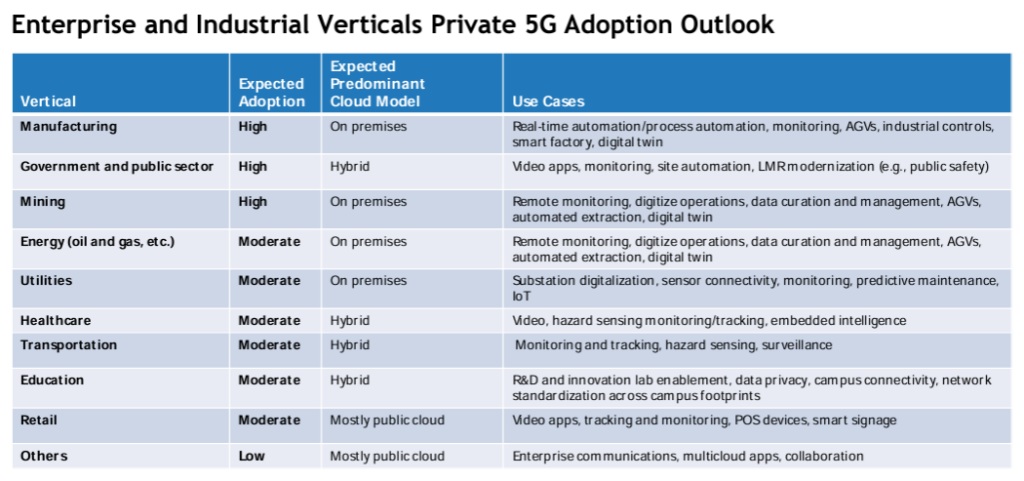Private Mobile Networks Are Good. Private Mobile Clouds Are Better.
In today’s digital age, enterprises are increasingly turning to Private Mobile Networks (PMNs) powered by 4G and 5G technologies to boost performance, productivity, and security for specialized applications + devices, as well as to ensure resilient mobile coverage everywhere. They offer a range of services and capabilities beyond traditional enterprise wireless networks or public cellular connectivity, but they do bring their own set of challenges.
If you’re a forward-leaning CIO or networking leader looking to navigate the complex world of PMNs, you might want to look at the newer concept of Private Mobile Clouds (PMCs). PMCs take the benefits of PMNs further for the enterprise or public institution by providing a familiar cloud operating model (vs. standalone telco-centric equipment), including the ability to rapidly deploy and scale a full set of mobile services through a single interface.
PMNs: Overview & Challenges
Private mobile networks (PMN) emerged over the last decade, evolving from proprietary wireless systems to today’s sophisticated privately operated 4G and 5G networks. Initially used by enterprises and public organizations for secure communication, PMNs grew with advancements in spectrum allocation (including free spectrum like CBRS) and network technology, and today are used to support both cellular voice/data extension as well as modern use cases like industrial automation and robotics, among others.
Compliant with cellular standards and incorporating 4G/5G technologies, PMNs provide mobile voice and data services tailored to specific enterprise locations, spanning from corporate and university campuses to broader geographic areas. They cover everything from basic mobile network elements such as RAN and packet core to services like SIM management, edge computing, network security, orchestration and user equipment devices – though usually through a set of standalone components or pieces. Advanced services can include vendor or third-party system integration with IT/OT, professional services, and use case/application design.
Enterprises have slowly but steadily been adopting PMNs to supplement or replace legacy wireless technologies such as Distributed Antenna Systems (DAS), or to augment existing Wi-Fi networks for modern, extended mobility use cases like robotics. Purchase drivers have included scalability, resilient connectivity, and future-ready design.
Industries leveraging PMNs span a range of sectors including manufacturing, warehousing, utilities, smart buildings, ports, airports and agriculture.

Source: IDC, 2021
Despite PMNs’ integration of a broad set of advances in mobile technology and their associated benefits, organizations continue to face a difficult path when looking to source, deploy and operate them. There are a variety of PMN vendors and sources including veteran telco infrastructure companies, system integrators, mobile network operators (MNOs), and a few specialized startups. Choosing among different technology and deployment models has to date involved navigating a complex ecosystem of infrastructure, apps, devices, and integration expertise. It also requires a high degree of knowledge in deploying and operating traditional telco-centric cellular equipment – often many different components and vendors. In the end, it often requires hiring a third-party specialty system integrator to achieve the desired time-to-service and business outcome(s).
To address these challenges with, as well as the benefits of, PMNs, a few specialized startups – notably Highway 9 Networks – have worked to carefully aggregate a broad set of PMN capabilities and additional mobile functionality into a single cloud-native platform called a Private Mobile Cloud (PMC).
Private Mobile Cloud: PMN + much more
The concept of Private Mobile Cloud (PMC) represents a major step forward in architecture (and business outcomes) for enterprise mobile connectivity. The architecture provides an overlay of a broad set of mobile services on top of a unified platform for provisioning, enterprise infrastructure and mobile carrier integration, as well as underlying cellular network connectivity.
Unlike the traditional approach used in PMNs of deploying multiple separate telco network components like radios, spectrum management, SIM management, etc. – each with their own provisioning processes and management screens – a PMC integrates much of these components onto a single cloud-native, enterprise-based private platform (hence private mobile cloud).
The objective of a PMC is to greatly simplify the deployment and management of a [private] mobile network within enterprise and campus environments – as well as to reduce purchase and operating costs. By leveraging a PMC and its cloud-native operational model, an organization can streamline and accelerate the deployment of their mobile network, more rapidly integrate with their existing on-premises network / security infrastructure + policies and minimize ongoing management complexity.
By leveraging the same (and very familiar) type of cloud-native operating model used with other types of infrastructure (compute, data, storage, etc), organizations can benefit from Day 1 deployment (e.g. a software-defined onboarding process) to ongoing Day 2 operations (e.g. the ability to dynamically scale and make changes through simple console-based workflows; end-to-end visibility and control across the full mobile environment through a single console).
Conclusion
Despite growing recognition of advancements in mobile technology and private 5G, private mobile network adoption has been moderate-to-date with enterprises and public institutions balancing deployment and ongoing operational challenges against potential mobility benefits. The introduction of private mobile clouds, organizations can now “have their cake and eat it too” – i.e. leverage the wealth of new mobile technology like private 5G, free spectrum in US like CBRS, etc. – without the challenge of having to build an almost telco-level of expertise to acquire, design, deploy and operate a standalone private mobile network on-premises. Instead, they can license/subscribe to a single private mobile cloud platform for their enterprise mobility needs…today’s and tomorrow.
